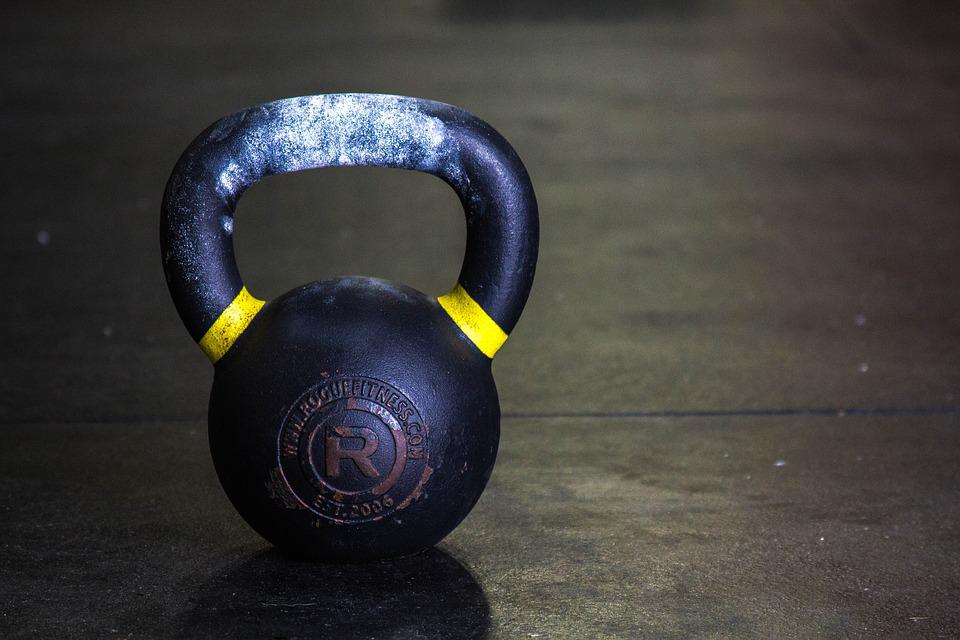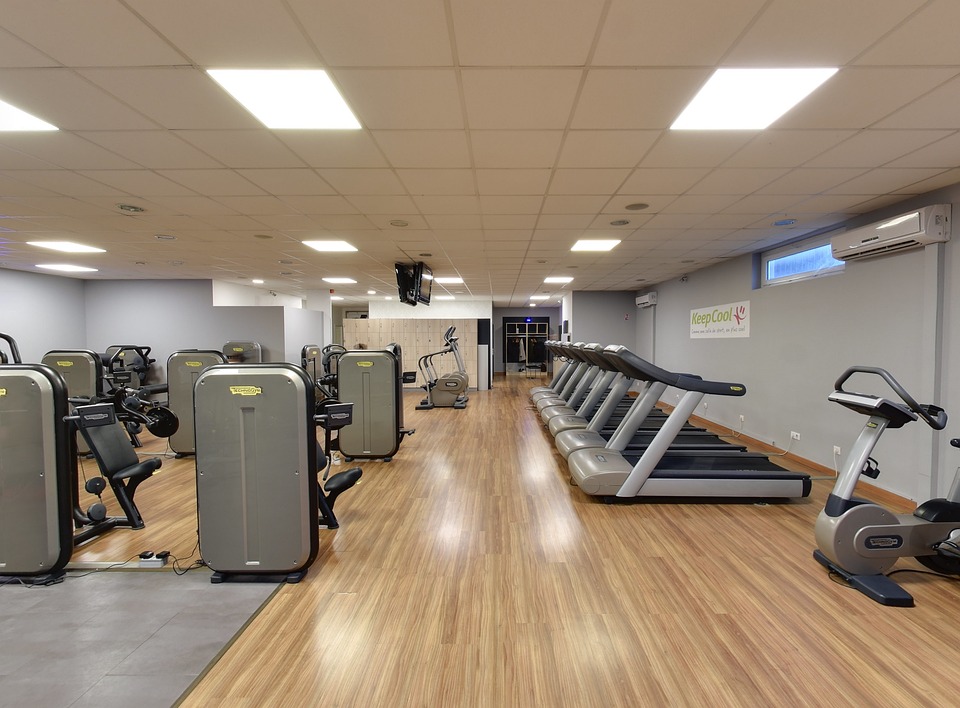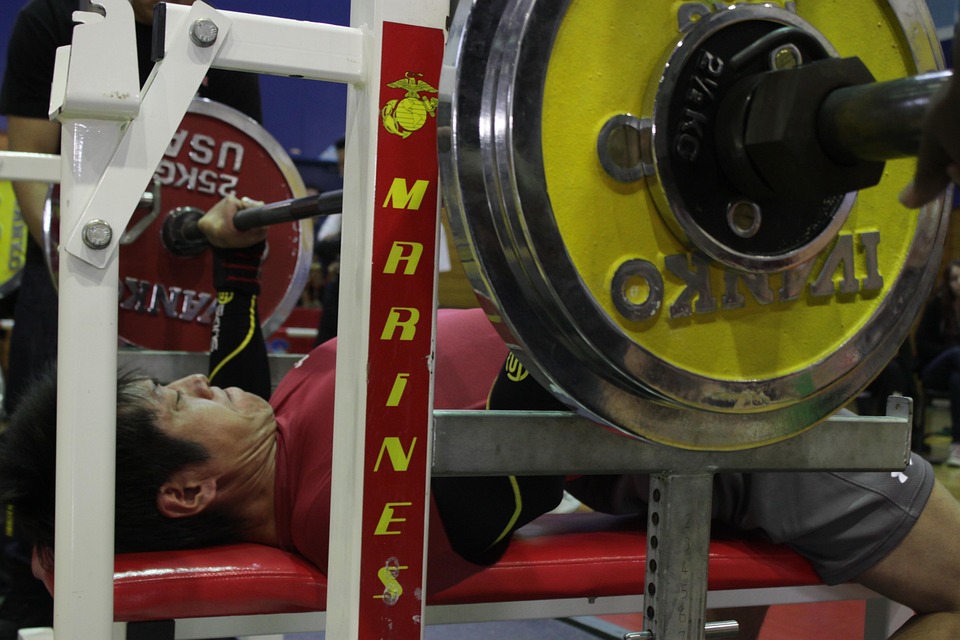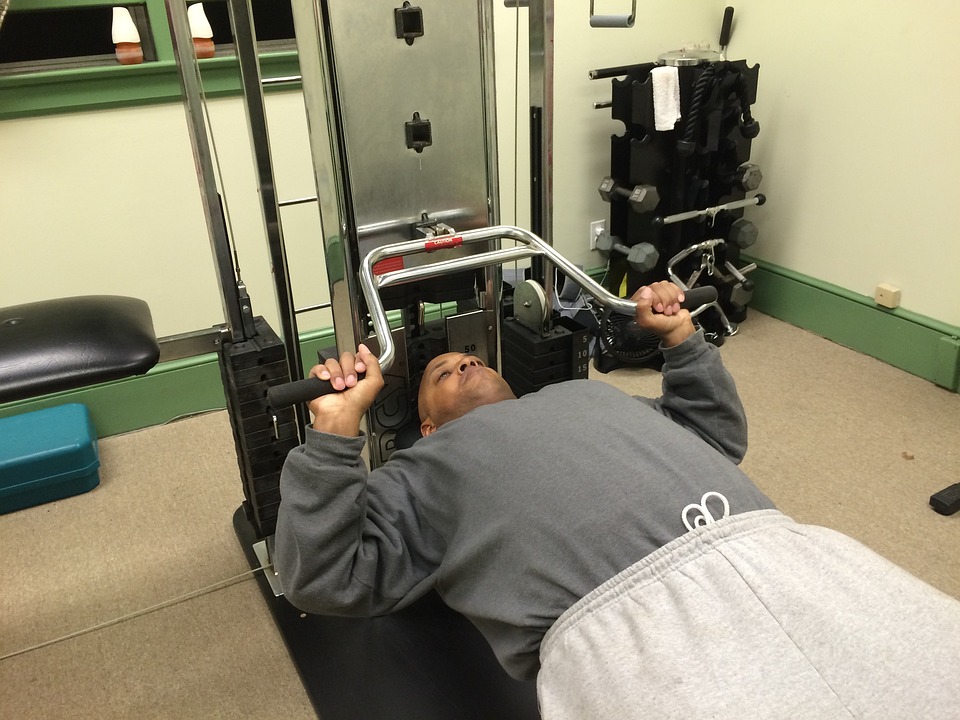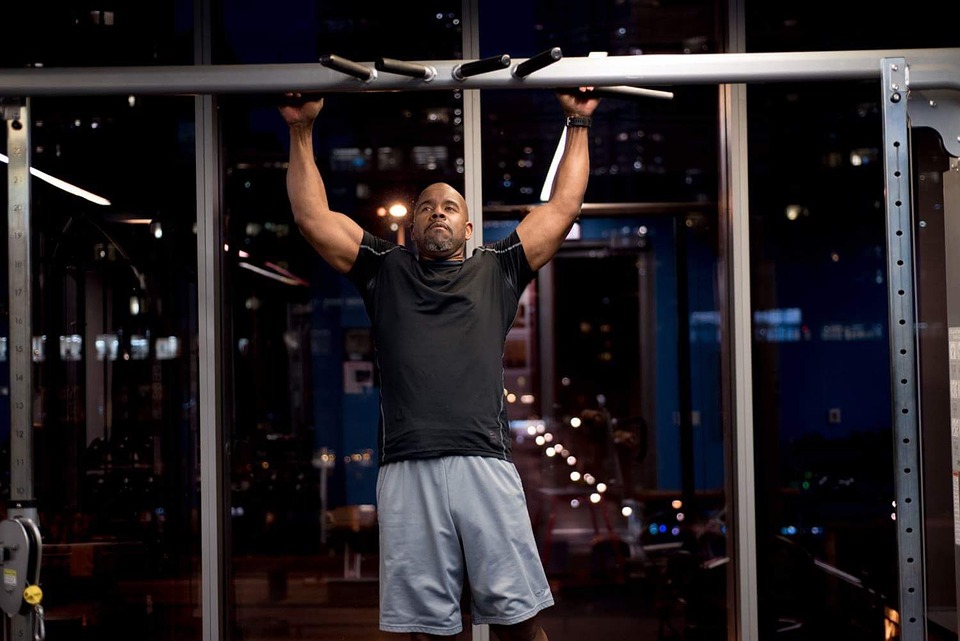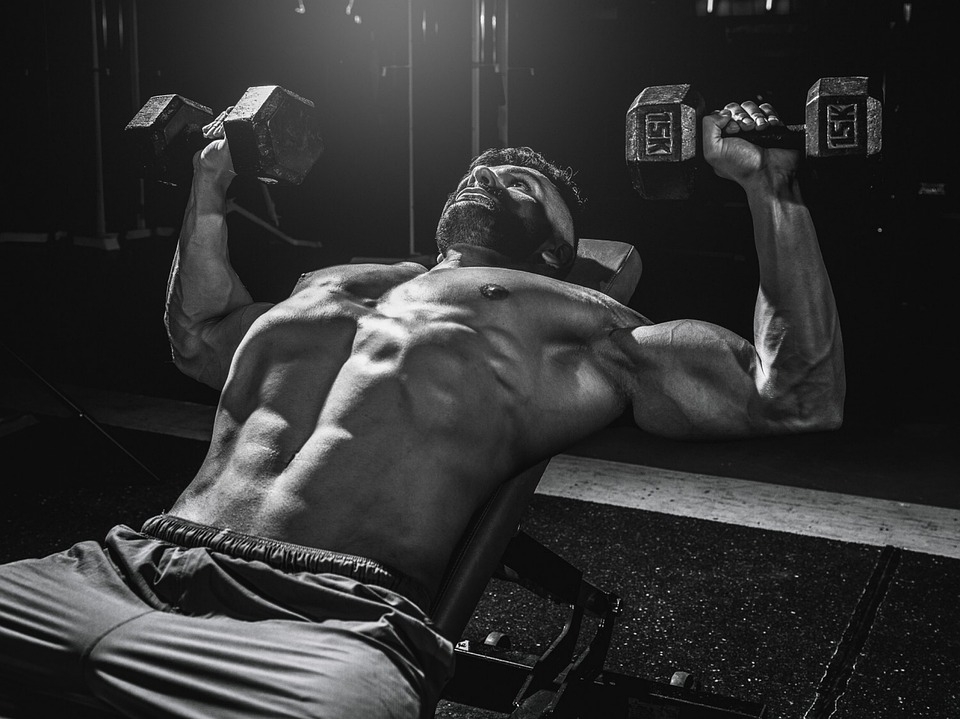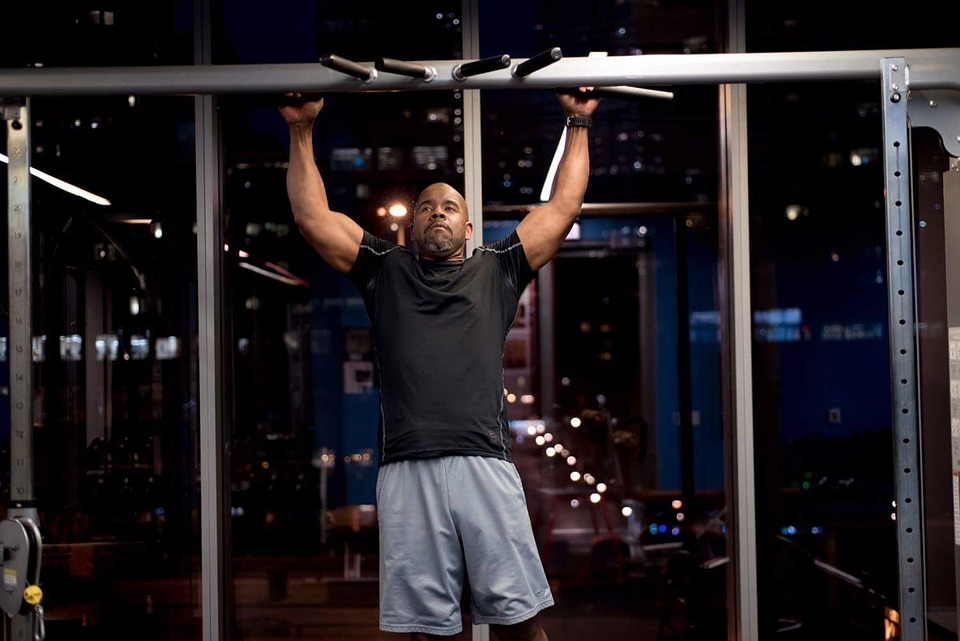
Pull-ups are an important part of many strength-training programs because they are an effective way of improving your overall pulling power, as well as developing your upper body and strengthening your back muscles. This movement targets multiple muscle groups by using a closed-chain movement. These muscle groups include your latissimus dorsi, deltoids, trapezius, rhomboids, biceps, triceps, forearms, and core.
Step-by-Step Guide to Doing a Pull-Up
Ready to try a pull-up?
- Stand on a block or a bench just below the bar.
- Grab the bar with an overhand grip (wrists pronated, with palms facing away from you) with your hands about shoulder-width apart.
- Allow your feet to come off the block/bench and gently let your body hang. In this dead hang position, your arms should be fully extended.
- Engage your core and find full-body tension by squeezing your glutes and flexing your quads.
- To initiate the pull, depress your lats (imagine pulling your shoulder blades down and into your back pockets) and then start pulling upward to bring your chin over the bar.
- Complete the pull by squeezing your lats together.
- Slowly extend your arms to return to a full hang position while maintaining full-body tension.
Common Pull-Up Problems
If you want to avoid injury and stimulate muscle growth, use the correct form when doing pull-ups. There are some mistakes that women often make while doing pull-ups.
The good news? The following four errors can be corrected easily. To avoid wasting energy, be sure to stay aware of your surroundings and actively avoid any obstacles.
Error #1: Eye Position
The movement will be more difficult if you look at the bar during it.
When doing this exercise, keep your neck in a neutral position and your eyes focused in front of you, not on the bar. Imagine holding an orange between your chin and chest.
Error #2: Lack of Lat Engagement
If you’re having trouble completing the pull-up motion, it might be because you’re not engaging your lat muscles.
When you are about to start your pull, think about pushing your lats down and back. This will allow for better muscle recruitment in the back and less strain on the biceps.
Error #3: Lack of Full-Body Tension
While performing a pull-up, it is easy to focus only on pulling the body upward and forget to maintain tension throughout the whole body. This can make it harder for us to finish the movement.
When doing a pull-up, it is important to focus on generating and maintaining full-body tension. This will help you to effectively perform the exercise and avoid injury. To engage your core, imagine spreading tension from your glutes down to your toes. Doing this exercise will help you to not only finish the repetition but also get stronger.
Error #4: Lack of Strength and Elbow Drive
If you don’t have enough strength and arm drive to pull the bar up, you might end up shrugging your shoulders to get your chin over the bar. When we shrug our shoulders, we are using our traps muscle more than we are using our latissimus dorsi muscle.
Try to avoid hunching your shoulders when you ride. Instead, imagine squeezing your elbows together and maintaining a long neck position.
How to Get Strong Enough to Do a Pull-Up
Before most women can get their first pull-up, they need to train. This activity demands a lot of strength in the upper body, which is something we don’t often get through other activities in our daily lives.
There are several exercises that can help you build the strength you need for a foundation. Don’t forget to keep doing the exercises that got you to the point where you could do a pull-up in the first place once you’ve mastered the move. Incorporating these movements into your workout routine will help you maintain your strength and fitness level.
6 Exercises to Train Your First Pull-Up
The following exercises will help build your strength for your first pull-up. Complete 3–4 sets of 8–10 reps each.
Hollow Hold
- Lie on your back and contract your abs while pressing your lumbar spine (lower back) into the floor.
- Slowly raise your head, arms, and legs off the ground.
When you feel confident with the hollow hold, you can try hollow rocks. To do this, stay in the hollow hold position and rock your body back and forth. Your shoulders and hips should not move or be used to generate momentum.
Hollow Hangs
- Hang with straight arms from the pull-up bar with an overhand grip.
- Pull your body into the same hollow position you did on the ground with hollow rockers and hold for 10–30 seconds.
- Maintain tension throughout your body, from your shoulders to your feet.
Scapular Pull-Ups
- Follow the cues above to find your hollow hang position.
- While holding the hollow hang, draw your shoulder blades down and back.
Doing this exercise will help you learn how to use your lats to initiate a pull-up, as well as strengthen the muscles in your shoulders and back. Additionally, it will help you stay tight at the start of your pull.
Kettlebell Bottoms-Up Hold
- Start with your feet shoulder-width apart and the kettlebell in front of you, its handle perpendicular to your body. Grab the kettlebell with one hand, and either clean it or curl it to a bottoms-up position.
- With the bottom of the kettlebell facing upward, begin with a single-arm bottoms-up hold.
- To prevent the kettlebell from falling, engage your core, activate your lat, and maintain full-body tension.
This drill will help improve your grip strength, core strength, and stability in your shoulders. Progress to a bottoms-up overhead press when you’re ready.
Inverted Rows
- Lying in a supinated position, grab the rings (you can also do this with a TRX).
- Engage your core, flex your quads, and squeeze your glutes. Row to bring your body toward the rings so that your body is parallel to the ground.
- Extend your arms to return to your starting position.
You can make the inverted row easier by bending your knees until you can pull your own body weight safely.
Slow Negative Pull-Ups
- Start in a flexed hang position, holding yourself up with your chin above the bar.
- Slowly allow your body to descend until you reach a hollow hang position. The key here is controlling the drop.
Negative pull-ups are a great way to gain a full range of motion while working on strength.
How to Perform the Weighted Pull-Up Step by Step
Weighted pull-ups are a great way to show full-body strength, coordination, and upper-body stability. Therefore, you will often see pull-ups in training routines that are designed to be comprehensive. If you want to get stronger and bigger, you can do so by adding weight to your movements. This will make the movements more intense, and you will see more gains in strength and size.
The weighted pull-up is mostly defined by the fact that your grip is overhand, and also by the added weight. We will assume that you have access to a weight belt, dumbbell, weighted vest, or some other external load. With that said, here’s a breakdown of the technique.
Step 1 — Get Your Grip
How you place your hands will determine how much help your muscles will have during each repetition. To begin, walk up to the bar and raise your arms above your head in a comfortable position. This should be a comfortable starting grip width.
The coach suggests that different grips can be used to help with training progress and goals.
Step 2 — Set and Hang
A stable surface will help you grab the bar at your chosen grip width. You should grip the bar so that there is enough space for your body to hang freely. Tense your grip on the bar and brace your glutes and core for stability.
The coach advises against jumping into position while performing weighted pull-ups, as the weight belt and attached plates may sway and cause you to lose your grip or stability.
Step 3 — Pull With Purpose
When your body is tense and your lats are in a good position, they can do most of the work with some help from the biceps. While contracting your lats, pull with your arms until you reach the end of the range of motion.
The coach’s tip is that you should lower the bar until it is level with your chin.
Step 4 — Lower Under Control
A proper technique during each repetition is crucial for maintaining control of your descent. While lowering yourself back to the starting position, keep the tension locked in. The risk of swaying your body or the attached weight makes it difficult to produce the force necessary for the next repetition.
Eccentric pull-ups are a great way to increase the difficulty of your workout while still using your body weight.
Benefits of the Weighted Pull-Up
Weighted pull-ups act as an expression of full-body functionality. performing weighted pull-ups can help you develop proprioception, which is awareness of your body in space. This can help you grow the muscles involved, as well as improve your overall strength.
Expression of Function
Successfully completing weighted pull-ups requires being physically fit in many ways. In order to perform a weighted pull-up, one must have strong and stable shoulders, the ability to generate full body tension and a strong shoulder girdle.
When these boxes are checked, you can be sure that there will be a lot of carryovers to exercises that are done regularly and to tools that will be useful.
Injury Risk Management
The pull-up position with added weight lets you know of any large differences in strength or ability to move at the shoulder. If left unchecked, discrepancies could predispose you to injury.
The opposite of that is that if you keep successfully loading and progressing with weighted pull-ups, your muscles, and joints will be much safer during other exercises that may have high stability demands, such as various pressing movements.
Balance and Control
The weighted pull-up is a good way to practice your balance and body control because you have to control the external load as well as your body weight. Having good proprioception (knowing where your body is in space) and spatial awareness (knowing where things are in relation to you) can help you avoid accidents while doing other activities.
Strength and Hypertrophy
One way to develop both strength and hypertrophy is through weighted pull-ups. The strength needed to perform bodyweight pull-ups is significant, but when you add an external load, the challenge of neutralizing any unwanted movement requires even more coordination and strength. If you want to improve your muscle growth, adding weight to your pull-ups will help improve the growth in your back, biceps, and shoulders.
Weighted Pull-Up Variations
The weighted pull-up can be performed using different grip positions and grip widths. It is important to choose the right grip when doing a pull-up, as some choices can change which muscles are used while others make the pull-up more difficult.
Weighted Neutral-Grip Pull-Ups
Instead of using a pronated grip, use a parallel grip with your palms facing each other. The position of your grip when exercising can affect how easy or difficult the reps are.
Weighted Chin-Ups
Grip the bar with your palms supinated (underhand). Pull-ups with a neutral grip involve more arm muscle than pull-ups with an overhand grip.
Wide-Grip Weighted Pull-Ups
The wide-grip weighted pull-up increases the challenge of the exercise by reducing the leverage of your muscles. This variation is perfect if you want a real challenge because it makes the upper back carry more of the total load.
Weighted Pull-Up Alternatives
While calisthenics may not be your thing, you can still reap some of the benefits of a weighted pull-up without ever doing one.
Unanchored Lat Pulldowns
If you don’t hook your legs in the lat pulldown station, you’ll have to use more full-body tension to move the load without changing your body’s position. This is a great alternative to weighted pull-ups if you want to improve your skills and increase body tension.
Weighted Inverted Row
The inverted row is a great way to use your body weight while still being partially supported. The weighted pull-up is defined by many elements including core stability, loadability, and compound stimulation. The inverted row is a great beginner exercise for those just getting started with back training.
Final Word
The pull-up is a “Swiss army knife” exercise. It is versatile and can be adapted to achieve almost any training goal or serve any purpose. More weight can help create new muscle growth, increase your lifting strength, and improve your other exercises.
The weighted pull-up is a great addition to your workout routine because it is very effective and provides extra core and stability work. You can get a lot out of a little if you look no further.

